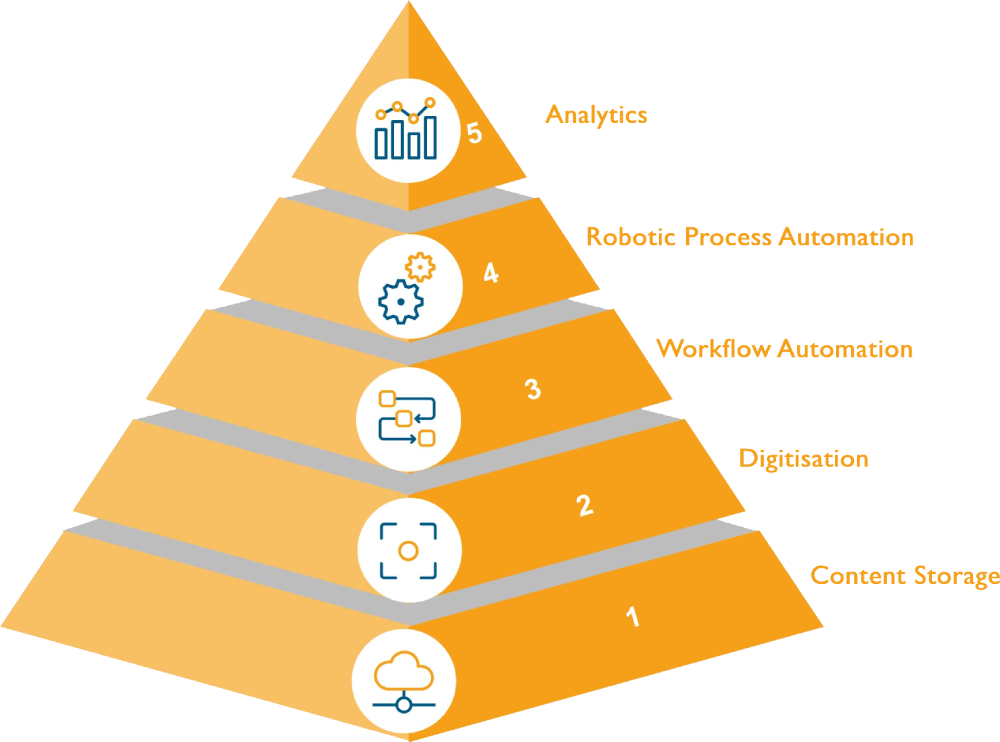Document Digitisation Services
Efficiently manage and utilise critical assets in a hybrid physical-digital environment
Seamlessly transition from physical to digital within a unified asset framework, converting unstructured records into structured formats to uncover valuable insights through automation.

Digital transformation encompasses many aspects, and each journey is unique to your industry, goals, and objectives. However, there are universal reasons for change, such as inefficiencies caused by data silos, which can lead to poor governance and an inability to leverage valuable insights to stay competitive. Ensuring all valuable information is converted from paper to digital maximises accessibility and usability, enabling paperless operations in increasingly hybrid environments.
In essence, investing in digital transformation allows you to access information from any source—physical or digital, and on any media. It ensures consistent data and information management to minimise both internal and external risks, structures unstructured information to maximise its value, and empowers your employees to achieve your business goals.
Crown’s chronicles of digital innovation
Your business deserves the best possible document digital innovation. Our technical expertise and business domain knowledge make us the ideal choice to design, build, and manage an exceptional journey for you.
We create a journey tailored to your business’s unique needs and regularly review it to determine if upgrades or adjustments are necessary.
It’s essential to understand what your digitisation looks like, not only to know where to perform certain tasks but also to:
- Comprehend all the components and how they attract new business
- Identify gaps that need custom solutions


1. Content Storage
No more spending hours searching for required documents through file cabinets. You can now quickly access your information in a centralised, secure digital storage repository that is safeguarded against unforeseen situations. Eliminating unnecessary physical storage frees up space, allowing you to create a more flexible workspace

2. Digitisation
By digitising documents, you enhance accessibility and boost productivity on your projects. Currently, and likely for the foreseeable future, employees are working in a hybrid model. This mix of physical and digital files can lead to accessibility issues, which in turn affects productivity

3. Workflow Automation
Your team can now develop automated workflows for document-centric processes, eliminating repetitive and time-consuming tasks such as asset management, HR processes, and invoice processing. This allows your team to focus on more valuable work, leading to increased productivity and more opportunities for brainstorming new ideas.

4. Robotic Process Automation
Automate repetitive, rule-based tasks with software robots, freeing up human resources for more strategic work. These robots can interact with digital systems and applications to perform tasks such as data entry, transaction processing, and report generation

5. Analytics
Digitising your files and utilising advanced analytics allows your team to uncover patterns, trends, and other valuable insights
Why should you begin documenting your digital innovation?

Better Data Management
Digital transformation improves data management, making it easier to collect, store, analyse, and use data effectively

Increased Agility
Digital transformation enables companies to be more agile and responsive to market changes. This flexibility is crucial in today’s fast-paced business environment

Innovation and Growth
Embracing digital technologies fosters a culture of innovation, allowing companies to develop new products and services, enter new markets and drive growth

Enhanced Security
Digital transformation allows companies to implement advanced security measures such as multifactor authentication, encryption, and network segmentation

Competitive Advantage
Leveraging emerging technologies like artificial intelligence, machine learning, and big data can provide insights into customer behaviour, streamline operations, and improve decision making
From managing a single task to full-scale business automation

Document storage and retrieval
Efficiently store and retrieve documents with advanced search capabilities, ensuring quick access to critical information

Version control
Maintain comprehensive version histories and track changes to documents, ensuring accuracy and accountability

Collaboration tools
Facilitate real-time document sharing and collaboration among team members, enhancing productivity and teamwork

Workflow automation
Streamline and automate repetitive tasks and document workflows, reducing manual effort and increasing efficiency

Security & compliance
Ensure robust document security and compliance with industry regulations, protecting sensitive information

Metadata and tagging
Enhance document searchability by adding metadata and tags, making it easier to locate and manage files

Integration
Seamlessly integrate with other softwares and / or email systems, creating a unified and efficient digital ecosystem
Push the limits of productivity!
What work processes can be converted into digital workflows?
Measuring Success: Key Statistics in Driving Digital Transformation
*1 : Mordor Intelligence. (2024). Document Management System Market Size & Share Analysis – Growth Trends & Forecasts (2024 – 2029). Retrieved from https://www.mordorintelligence.com/industry-reports/document-management-systems-market
*2 : Backlinko. (2024). 16 Digital Transformation Statistics. Retrieved from https://backlinko.com/digital-transformation-stats
*3 : Mordor Intelligence. (2024). Document Management System Market Size & Share Analysis – Growth Trends & Forecasts (2024 – 2029). Retrieved from https://www.mordorintelligence.com/industry-reports/document-management-systems-market
*4 : Document Logistix. (2024). Document Management Trends in 2025: What to Expect. Retrieved from https://document-logistix.com/document-management-trends-in-2025-what-to-expect/




















